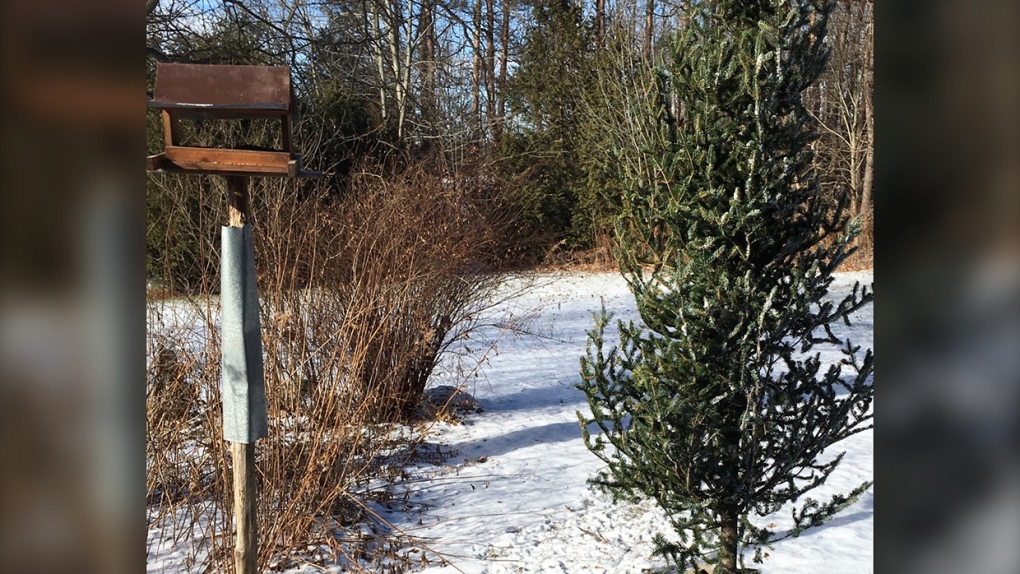Keeping your Christmas tree in the backyard is good for environment: Nature Conservancy of Canada
 Leaving a tree in the backyard can provide important habitat for bird populations during the winter months, especially on cold nights and during storms.
Leaving a tree in the backyard can provide important habitat for bird populations during the winter months, especially on cold nights and during storms.
For those looking to find a second act for your Christmas tree, consider just leaving it in the backyard.
The Nature Conservancy of Canada suggests letting the urban wildlife that is part of everyone's garden and backyard do the recycling themselves, instead of having the city haul it away.
Leaving a tree in the backyard can provide important habitat for bird populations during the winter months, especially on cold nights and during storms, according to the NCC's national conservation science manager, Samantha Knight.
The conservancy calls this practice a small act of conservation.
The process starts with location: simply prop it against another tree, the fence or else lay it in the garden.
You can even redecorate it with treats to attract wildlife, like peanut butter-filled pine cones, strings of peanuts, or suet for birds to chew on at the same time they take shelter in the tree.
“Evergreens offer a safe place for birds to rest while they visit your feeder,” said Knight. “Another benefit is that if you leave the tree in your garden over the summer, it will continue to provide habitat for wildlife and improve your soil as it decomposes.”
By spring, the tree will have lost its needles. At that point, you can cut the branches and add them to your garden, then lay the trunk of the tree in the soil but not on top of any flowers.
 Leaving a tree in the backyard can provide important habitat for bird populations during the winter months, especially on cold nights and during storms.
Leaving a tree in the backyard can provide important habitat for bird populations during the winter months, especially on cold nights and during storms.
Branches and trunk provide habitat, shelter wildflowers, hold moisture and enhance soil. Frogs may seek shelter under the log, and insects, like carpenter bees, may burrow into the wood.
“By fall, the branches and trunk will begin to decompose and turn into soil,” said Knight. “Many of our Christmas trees, particularly spruce and balsam fir, have very low rot resistance and break down quickly when exposed to the elements. The more contact the cut branches and trunk have with the ground, the quicker it will decompose. Drilling holes in the tree trunk will speed up that process."
CTVNews.ca Top Stories

Alberta RCMP officer charged with 2 counts of sexual assault
Const. Bridget Morla, a Leduc RCMP officer, has been charged with two counts of sexual assault in connection with an incident that happened two years ago.
Ontario dad removes hockey rink at heart of neighbour dispute
A Markham dad who drew the ire of neighbours and the city after installing a hockey rink in his backyard says the rink has now been taken down.
Motivated by obsession: Canadians accused in botched California murder plot in police custody
Two Canadians are in police custody in Monterey County, California, after a triple stabbing police say was motivated by a B.C. man's obsession with a woman he played video games with online.
Kingston, Ont. doctor in 'disbelief' after being ordered to repay $600K for pandemic vaccination payments
An Ontario health tribunal has ordered a Kingston, Ont. doctor to repay over $600,000 to the Ontario government for improperly billing thousands of COVID-19 vaccinations at the height of the pandemic.
Trump demands immediate release of Oct. 7 hostages, says otherwise there will be 'HELL TO PAY'
President-elect Donald Trump is demanding the immediate release of the Israeli hostages still being held in Gaza, saying that if they are not freed before he is sworn into office there will be “HELL TO PAY."
Belly fat linked to signs of Alzheimer’s 20 years before symptoms begin, study says
As the size of a person’s belly grows, the memory centre of their brain shrinks and beta amyloid and tau may appear — all of this occurring as early as a person’s 40s and 50s, well before any cognitive decline is apparent, according to new research.
AC/DC announces North American stadium tour, Vancouver lone Canadian stop
Big news for AC/DC fans as the heavy metal bigwigs announced Monday they will hit the road next spring. But as of now, there’s only one Canadian show on the docket.
Alleged gang member driving from U.S. arrested at Canadian border after making wrong turn
An alleged gang member coming from the United States was arrested at the Canadian border after reportedly making a wrong turn onto the Peace Bridge border crossing.
Nova Scotia lawyer suspended following ugly courtroom fracas
A Nova Scotia lawyer who had to be restrained by deputy sheriffs during a court appearance earlier this year has lost his appeal of a suspension following the bizarre incident.































